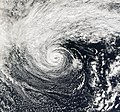File:Storm 91C 01 nov 2006 2030Z.jpg
Jump to navigation
Jump to search

Size of this preview: 642 × 599 pixels. Other resolutions: 257 × 240 pixels | 514 × 480 pixels | 823 × 768 pixels | 1,097 × 1,024 pixels | 2,194 × 2,048 pixels | 6,000 × 5,600 pixels.
Original file (6,000 × 5,600 pixels, file size: 5.91 MB, MIME type: image/jpeg)
File history
Click on a date/time to view the file as it appeared at that time.
| Date/Time | Thumbnail | Dimensions | User | Comment | |
|---|---|---|---|---|---|
| current | 18:58, 2 January 2010 |  | 6,000 × 5,600 (5.91 MB) | Supportstorm | Reverted to version as of 00:19, 3 November 2006 |
| 20:41, 29 December 2009 |  | 6,000 × 5,600 (5 MB) | Supportstorm | Image Adjustment: Auto levels on contrast and color | |
| 00:19, 3 November 2006 |  | 6,000 × 5,600 (5.91 MB) | Good kitty | == Summary == {{Information |Description=Tropical storms, as their name suggest, tend to form in the tropics. However, from time to time similar looking storms can form at higher latitudes. Extratropical storms have cold rather than warm cores and usually |
File usage
The following page uses this file:
Global file usage
The following other wikis use this file:
- Usage on de.wikipedia.org
- Usage on en.wikipedia.org
- Usage on nl.wikipedia.org
- Usage on pt.wikipedia.org
- Usage on simple.wikipedia.org
- Usage on tr.wikipedia.org
- Usage on www.wikidata.org
- Usage on zh.wikipedia.org

